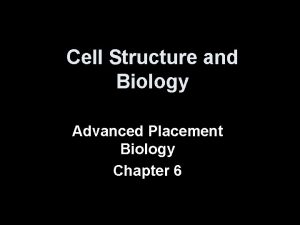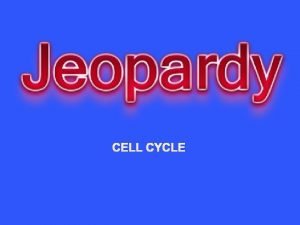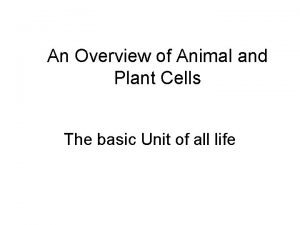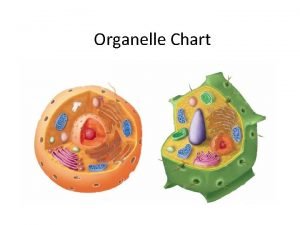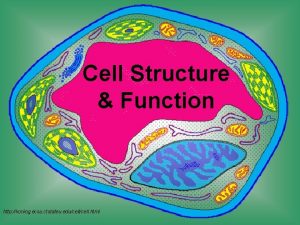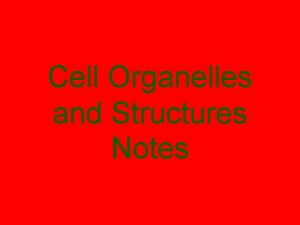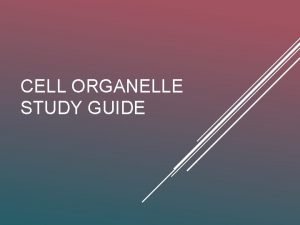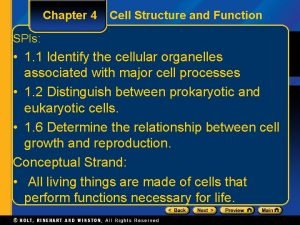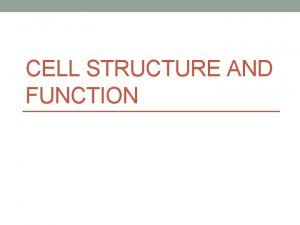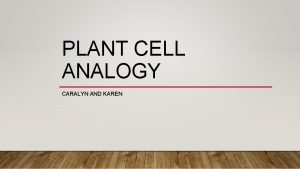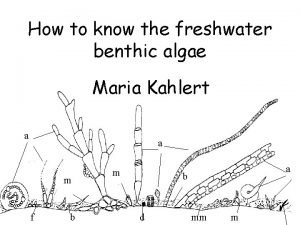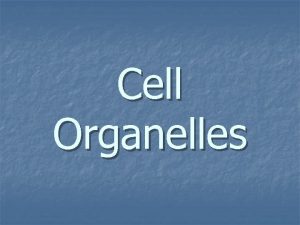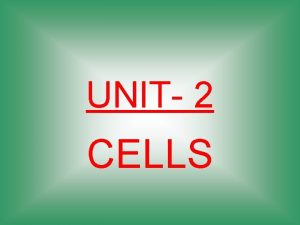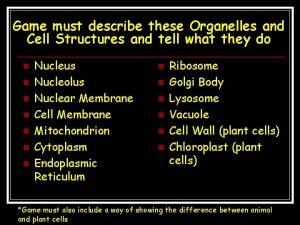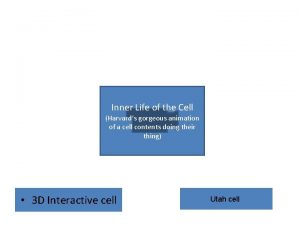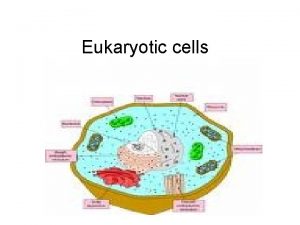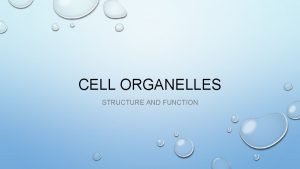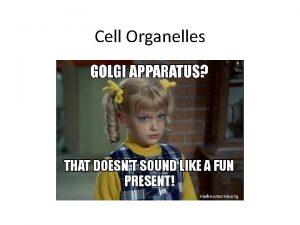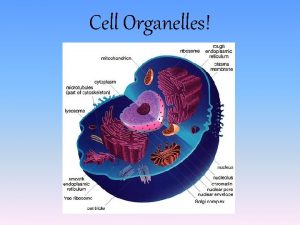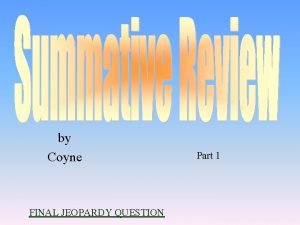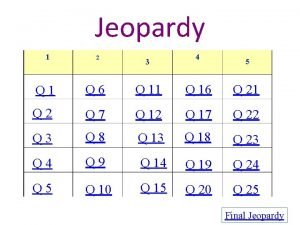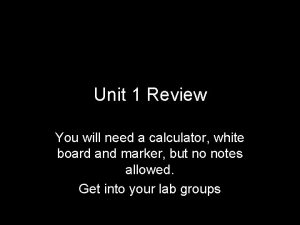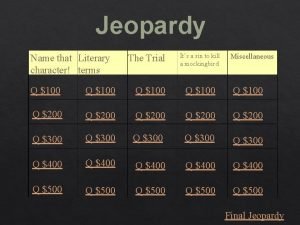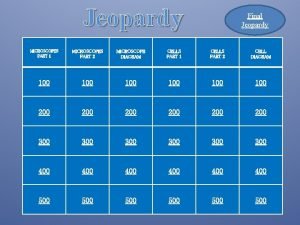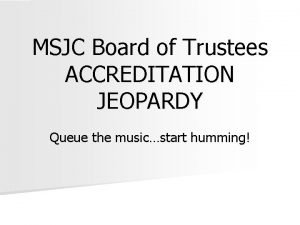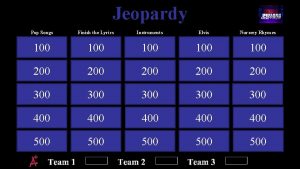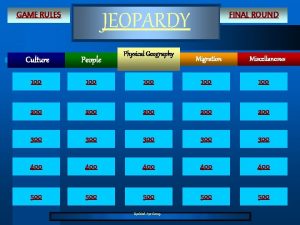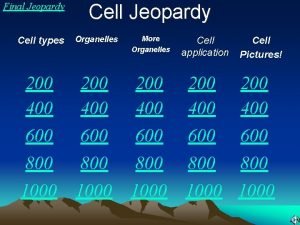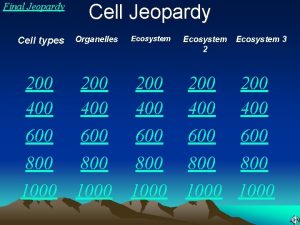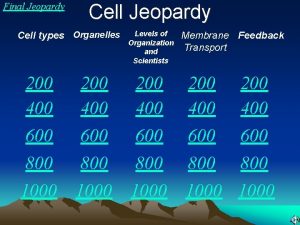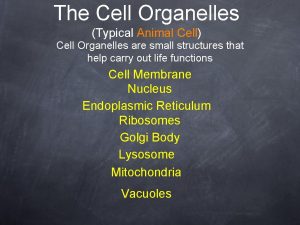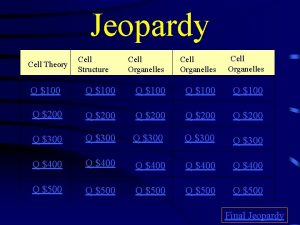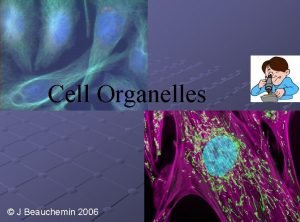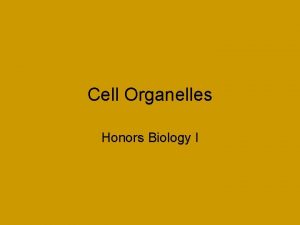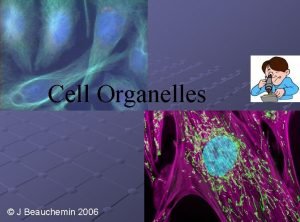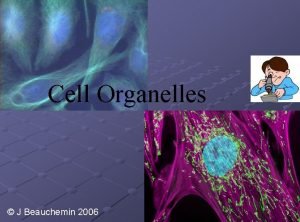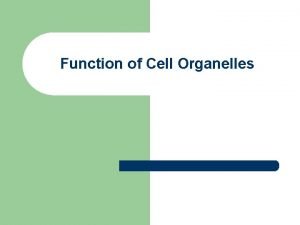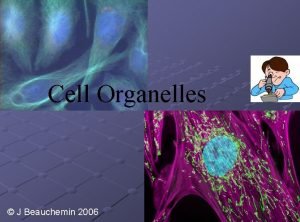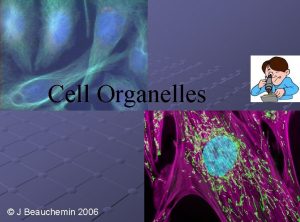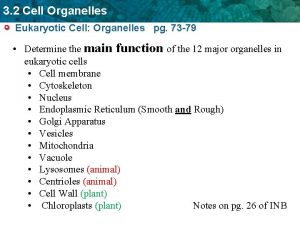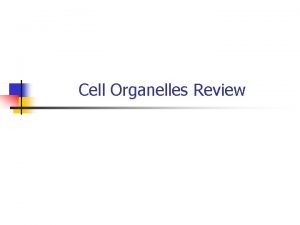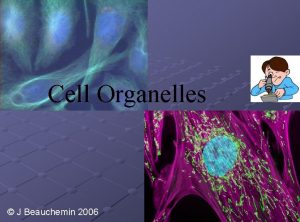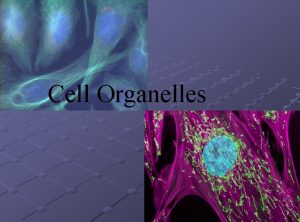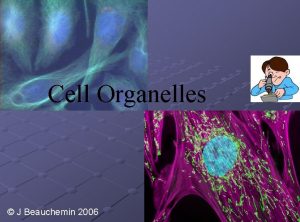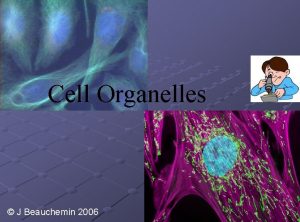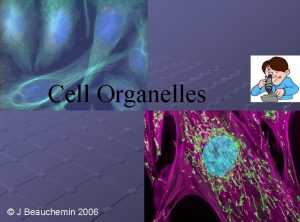Final Jeopardy Cell types Organelles More Organelles 200





















































- Slides: 53

Final Jeopardy Cell types Organelles More Organelles 200 400 600 800 1000 600 800 1000 Cell application Cell Theory 200 400

2 This is a type of cell without a nucleus and no membranebound organelles.

3 What is prokaryotic?

4 This term describes a cell with a nucleus and with membrane-bound organelles.

5 What is Eukaryotic?

6 This organelle is responsible for coordinating the cell activities and reproduction; sometimes called the “brain” of the cell.

7 What is the nucleus?

8 This cell type has a cell wall, chloroplasts, and often a big vacuole.

9 What is a plant cell?

10 This organelle only appears in plant cells and provides structure and support for the cell because it is made of cellulose.

11 What is a cell wall?

12 Proteins are made by this organelle

13 What is a ribosome?

14 This organelle produces, stores, and releases most of the energy needed by the cell; sometimes called the “powerhouse” of the cell.

15 What is a mitochondria?

16 This organelle is used to package materials for export out of the cell or movement around inside the cell. --This is a system of membranes that usually surround the nucleus.

17 What is the endoplasmic reticulum?

18 This organelle makes food for the plant, holds chlorophyll, and uses light energy to make glucose.

19 What is the chloroplast?

20 Name the two organelles found in plant cells only

21 What is: 1) vacuole 2) cell wall

22 1 2 3 Name three structures in this picture of human cheek cells. (must have all 3)

23

24 The arrow is pointing to the _____ in a plant cell.

25 What is a chloroplast?

26 This organelle modifies, packages and transports materials out of the cell.

27 What is are the Golgi Bodies?

28 This jelly-like material flows inside the cell membrane around all of the organelles.

29 What is the cytoplasm?

30 This is the protective layer around all cells and it regulates what goes into and out of the cell.

31 What is the cell membrane?

32 What digests worn out organelles, breaks down food molecules, and cell wastes?

33 What is a lysosome?

34 What is the difference between Rough endoplasmic reticulum and Smooth ER?

35 --Rough ER is ER that has ribosomes attached. --Smooth ER has NO ribosomes attached.

36 Which of the following would you not find in a bacterial (prokaryotic) cell? -ribosomes -cell membrane -golgi bodies -DNA

37 What is golgi bodies?

38 Who was the first person to describe cells when he looked at cork under his microscope?

39 Who is Robert Hooke?

40 What are three parts of the cell theory?

41 1. All living things are made of cells. 2. Cells are the basic unit of life. 3. All cells come from existing cells.

42 Name one scientist who contributed to the cell theory.

43 Matthias Schleiden Theodor Schwann Rudolf Virchow

44 What are the four main biomolecules?

45 Proteins Lipids Carbohydrates Nucleic Acids

46 The cell membrane is made of a bilayer of which molecule?

47 Phospholipids

40. Name this and this

49 Cytoplasm and membrane

50 What makes a cell eukaryotic?

51 What is the presence of a nucleus and membrane-bound organelles.

52 List two differences between plant and animal cells.

53 What is plants have a cell wall, and chloroplasts that animal cells do not have? --other answers too
 More more more i want more more more more we praise you
More more more i want more more more more we praise you More more more i want more more more more we praise you
More more more i want more more more more we praise you 100+200+200
100+200+200 Label the organelles in the composite cell
Label the organelles in the composite cell During interphase, a cell grows, duplicates organelles, and
During interphase, a cell grows, duplicates organelles, and Label the organelles in the composite cell
Label the organelles in the composite cell Cell organelles and their functions chart
Cell organelles and their functions chart ;
; White blood cell organelles
White blood cell organelles Nucleolus nickname
Nucleolus nickname Walls and studs organelle
Walls and studs organelle Section 4-3 cell organelles and features
Section 4-3 cell organelles and features Cell structures cell organelle graphic organizer
Cell structures cell organelle graphic organizer Cell organelles
Cell organelles Cytoplasm function in plant cell
Cytoplasm function in plant cell Aamfb
Aamfb Organelle graphic organizer
Organelle graphic organizer What is this cell
What is this cell Plant cell
Plant cell Cell organelles game
Cell organelles game Inner life of a cell harvard
Inner life of a cell harvard Cilia is used for
Cilia is used for Golgi vesicles function in animal cell
Golgi vesicles function in animal cell Post office
Post office Organelle
Organelle What is the smallest organelle in a cell
What is the smallest organelle in a cell 200+200+100+100
200+200+100+100 200+400+600+800
200+400+600+800 300+200+200
300+200+200 100 200 300
100 200 300 200+200+300+300
200+200+300+300 100 200 300
100 200 300 Euro 200 final
Euro 200 final Venn diagram of plants and animals
Venn diagram of plants and animals World geography final jeopardy
World geography final jeopardy 100 college questions
100 college questions Final jeopardy 2/2
Final jeopardy 2/2 What
What Jeopardy movie quotes
Jeopardy movie quotes Jeopardy final question today
Jeopardy final question today Final jeopardy christmas question
Final jeopardy christmas question Final jeopardy wager calculator
Final jeopardy wager calculator Jeopardy final question music
Jeopardy final question music What is mayella's version of what happened
What is mayella's version of what happened Todays final jeopardy answer
Todays final jeopardy answer Colonial america final jeopardy
Colonial america final jeopardy Final jeopardy queue
Final jeopardy queue Jeopardy final question music
Jeopardy final question music Random final jeopardy questions
Random final jeopardy questions Judith kuster
Judith kuster Geographic regions final jeopardy
Geographic regions final jeopardy Final jeopardy 12/16/20
Final jeopardy 12/16/20 Ancient greek philosophers final jeopardy
Ancient greek philosophers final jeopardy Geographic regions final jeopardy
Geographic regions final jeopardy



